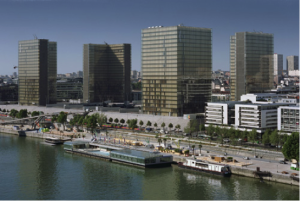In this month’s Feature Archive Section, Philippa Lewis (Leverhulme Early Career Fellow, University of Bristol) talks us through the process of researching at the Bibliothèque nationale de France.
In a recent interview, the former president of the Bibliothèque nationale de France, Bruno Racine, discussed the evolving nature of the library in the age of mass digitisation. The BnF’s digital site, Gallica, is undoubtedly changing the way researchers use the BnF as a physical space. Racine argues, however, that the library will continue to thrive as a destination. This is not only because certain works can’t be uploaded onto Gallica, but, he suggests, because the library offers researchers the ‘ideal working conditions’, something of a ‘“third space”, a home away from home’ (Chroniques de la BnF, 76, p. 21).

It seems somewhat counterintuitive to think of the BnF – particularly the Mitterrand site where I spent much of April this year – as homely. The building, rising high up above the surrounding streets of the 13th arrondissement with its four glass towers, like a strange ship moored on the banks of the Seine, easily inspires trepidation in the researcher. The scale of the Mitterrand site is huge, and its effect can be alienating. The procedure for entering the research library, situated on the lower level of the building (the rez de jardin), is bewildering at first. Before being allowed into the library proper, researchers need to log into their ‘personal space’ online, reserve a place in a reading room, and specify their arrival time. To access the research library, two long escalators lead from the haut de jardin to the lower level. The escalators glide slowly down through a vast, empty atrium: an eerie space, something of a cross between a cathedral and an airport.

Once in the research library, however, working conditions are very good, if not quite ideal: large desks, almost complete silence, and, of course, excellent collections (but still no wifi!). As the French national copyright library, with fourteen departments ranging from Manuscripts to Audiovisual, the BnF has something to offer anyone working in the field of French history.

Research library reading room © Alain Goustard / BnF
My postdoctoral project is examining changing attitudes to shyness in France in the long nineteenth century, moving between literary, moral, and medical spheres. Many of the sources I’ve been uncovering – out-of-print decadent novels written by doctors, short-lived medical journals, self-help manuals – are entirely inaccessible in the UK which means research trips to the BnF are essential. In April, I was able to consult almost everything I wanted across the departments at both the Mitterrand and Richelieu sites (Literature and Art, Science and Technology, Manuscripts, Performing Arts).

There were a few minor setbacks, however. It is rare to be able to access the originals of works published in the nineteenth and early twentieth centuries, meaning a lot of time spent on microfilm machines (and while you can photograph books, you can’t photograph microfilms). Books can be deemed hors d’usage if they are in particularly poor condition. Generally a demande de consultation exceptionnelle produces a favourable response, granting you access to the document for a limited period. One of the turn-of-the-century medical journals I needed to consult was deemed too fragile even after a special request, however, which was frustrating. Luckily, I was able to track it down at the Bibliothèque interuniversitaire de santé (BIUS) in the 7th arrondissement which is, by the way, an excellent place for anyone working on the history of medicine or the medical humanities in the French context.
But back to the BnF, and a few more practical points:
- Vigipirate: At the time of writing, extra security checks are in place at the BnF, but it doesn’t take long to go through them. Only the East entrance of the Mitterrand site is open which may affect the route you take to the library.
- Richelieu: Major renovation works are being carried out at the BnF Richelieu site until 2019 so check the documents you need to consult are accessible before you visit.
- Refreshments: The café at the Mitterrand site isn’t bad, but it is on the pricey side, so you might prefer to bring your lunch and eat it in one of the ‘clubs’. If you want to pop out for a while, you need to return your books and declare a sortie temporaire. There is currently no café at the Richelieu site.
The BnF may not exactly be homely and it can be frustrating, but, once you get the hang of it, it’s a great – and for many of us, essential – place for research.
Philippa Lewis
Philippa Lewis is a Leverhulme Early Career Fellow in the French Department at the University of Bristol. She has published articles on art criticism in Nineteenth Century French Studies and on Flaubert in Modern Language Review. Her new research project is a cultural history of shyness in nineteenth century France.
https://timidhistories.wordpress.com/



2 Responses
I wonder if you can explain how you go about finding and hiring a Paris based researcher to search the Bibliotheque Nationale? Thanks.